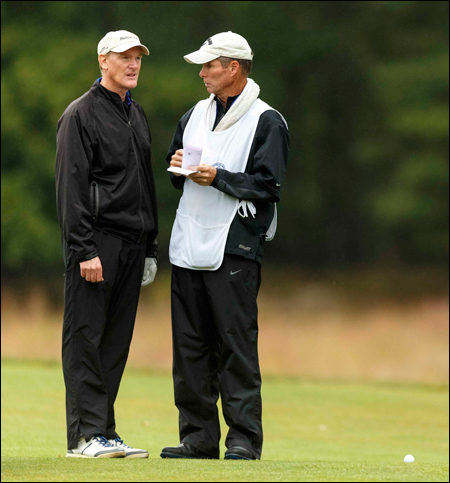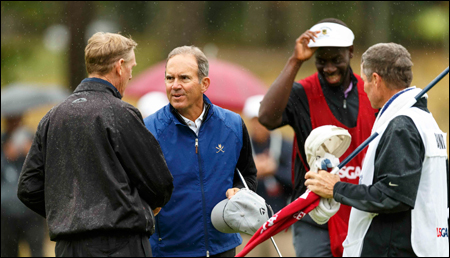Tom Brandes of Bellevue, Wash. made it to the final match of the 2015 U.S. Senior Amateur, which was held at Hidden Creek Golf Club in Egg Harbor Township, N.J., before falling to Chip Lutz, 5 and 3, in the final.

With his runner-up finish, Brandes receives exemptions into next week’s U.S. Mid-Amateur, as well as next year’s U.S. Amateur and U.S. Senior Open, plus a three-year exemption to the U.S. Senior Amateur.
Brandes has been named the WSGA Senior Men’s Player of the Year in 2010, 2011, 2012, 2013 and 2014. He is also on the WSGA Board of Directors.
Here is the post-match interview Brandes gave to the USGA.
TOM BRANDES: It was just kind of that way. It wasn’t the 30 footers that bothered me, it was the 15-footers or the — because at home you have a high percentage of making a 10-footer.
I mean, it was — like I said, my quote was, Honey, I can’t believe I missed so many 12-footers and I’m here.
Q. Here in the final.
TOM BRANDES: That’s kind of the way it was.
Q. It’s a little hard right in the aftermath, but the week as a whole, I know you spoke a little bit about it at the podium. Tell me about the week and how you feel about it overall, just getting to the championship match and how you got there.
TOM BRANDES: Well, it’s a dream come true. I’m a career amateur. I think Steve, I had read the article yesterday, he had been on the PGA Tour for many years. I think a lot of guys had tried professional golf at one point.
I’m a true career amateur. I really picked up golf at a late age, probably mid-30s. I didn’t play any U.S. Junior or any of that. Didn’t play college golf.
So for a career amateur, I mean, this is as good as it gets. Yeah.
Q. Now, when you say picked up golf in your 30s, does that mean starting or being competitive?
TOM BRANDES: Being competitive. I played a couple years in high school and then didn’t play any college golf but played a lot of other sports, basketball. Always fairly athletic.
Q. You went to Seattle University?
TOM BRANDES: Yeah.
Q. Did you play basketball?
TOM BRANDES: No. I played soccer at Seattle University. But funny, I went out for the golf team in the spring and I tried it for a couple weeks and said, Boy, I can do this later.
Q. A little too sedate maybe?
TOM BRANDES: Well, I had grown up in Eugene, and coming to the big city, Seattle, I wanted to enjoy college life. You know, like I said, I was away from home for the first time and big city.
You’d go out to practice and you would be — you would leave at 11:00 and back at 7:00 and I was eating by myself in the dorm. It’s like, you know, I can do this later.
So, yeah, essentially did. No, I mean, not only making the final, but just to get into any USGA event is a thrill for me. Maybe I set my sights too low. To make it this far is just over the top.
Q. How many USGA events is this for you approximately?
TOM BRANDES: Let’s see, I think 14, and then a British Senior Amateur. I lump that in there with it.
Q. Absolutely.
TOM BRANDES: Yeah, 14 or 15. Like I said, that’s three mid-Ams. I qualified for my first one in 1990, I think. That’s about when I really — I got a taste and went to a USGA event and I was like, Wow, this is really, really special, very special.
Q. That whetted your appetite?
TOM BRANDES: It did. It did. It’s like, I want to do this again. Yeah, it really did whet my appetite. Good way to put it. That was in ’90 or ’91.
Q. Obviously a very special week. Yesterday you had a marathon match, a very steady match where you finally made the shot you needed to to put you over the top. It was do-or-die thing on the 21st hole.
TOM BRANDES: That’s correct. Well, I had Tom, the media guy, he goes, I was looking at your match yesterday. Amazing statistic about your match with Steve was that he made one bogey in 21 holes and lost.
So that’s the kind of match it was. Yeah, on that 21st hole, I was telling my wife last night, you know, it was an all-or-nothing shot.
My attitude was, Well, I’m going to win this or lose this on this hole. It probably would’ve gone on forever. (Laughter.) We were both hitting fairways, hitting greens. Again, we could not make a putt.
So I said, Well, let’s just do this. I got it so close I couldn’t miss it.
Q. Now, the cumulative affect, obviously the USGA championship, to get to this point it’s a grueling test mentally and physically. You got to this morning, again an extremely early start.
TOM BRANDES: Dark.
Q. Yeah. So there the adrenaline of playing in a national championship, but you’re also battling fatigue mentally and physically, right?
TOM BRANDES: Yeah, absolutely. You know, the preparation was little or nothing this morning. I’ll never use any of that as an excuse, but it was just a little different challenge because I didn’t get — didn’t hit any chips or pitches.
I mean, literally I didn’t go out to the range because I knew it was going to be dark. The preparation was a little difficult, but didn’t bother Chip. Like I said, I’ll never use that as an excuse.
Q. You also have to weigh your fatigue and everything. How much is it going to weigh me down if I try to go out and beat balls in the dark for half hour?
TOM BRANDES: Absolutely. In these kind of events, if you’re hitting it well, you leave it alone. I didn’t hit a lot of balls, but it’s the touch shots that I like. That’s really the important thing, or the short game. The feel part is what I want to get.

Especially it went from really dry and fast to slow and wet, and, you know, how to get that to — adjust to that with the short game is more important than everything else.
Q. It was drizzly, windy, and cool, much cooler than it has been. Not that that’s bad conditions. But it wasn’t real fun out there necessarily.
TOM BRANDES: My hands were freezing. Yeah, my hands were very, very cold. But I didn’t bring any hand warmers or stocking cap. I borrowed rain pants. My wife at the last minute talked me into bringing a rain jacket.
I had tennis shoe golf shoes. Didn’t bring an umbrella. Yeah, but Chip just played better than I did. I just didn’t hit the shots that I needed to hit today. He played very well.
Q. Any point where you thought, Oh, if I could just cut into that a little bit?
TOM BRANDES: 10, the putt on 10. And the putt on 9.
Q. Seven feet maybe?
TOM BRANDES: Yeah, I had an uphill, looker uphill. If that would’ve gone on 9, would’ve changed the whole thing. And the one on 10, I mean, it was very, very doable there on 9 and 10.
Then 11 was going to hit 9 and the wind was just — I talked myself into the wrong club.
Q. It was swirling, wasn’t it?
TOM BRANDES: Yeah. I talked myself into the wrong club. So it went from really flipping it in my favor to hitting that 8-iron over the green and making bogey and getting flipped the other way.
But it was, you know, a good match throughout, I guess. The hole that I guess I got the most frustrated with was 13. I had 3-wood and the wind really picked up, and I got it in my head that 3-wood was too much.
Instead of waiting for the wind to die or go back and get a different club, I just kind of fanned the 3-wood. That bunker is no good. Yeah, so…
Q. One last question: You said you got a ton of e-mails and texts and everything last night and today now. Tell me about your support from folks at home. Oh, wow. Yeah, yeah.
TOM BRANDES: Yeah, great golf community in Washington. Actually in Oregon, Pacific Northwest. So tremendous support and comments from fellow competitors, and then also from my club.
Q. Which is?
TOM BRANDES: Rainier Golf Club in south Seattle. Don’t record this, but they live vicariously through you. Get an 18 handicaper — I’ve had guys give me golf balls. Would you play these in the tournament? They want to be part of it.
Q. That’s tremendous.
TOM BRANDES: It’s really amazing. Then neighbors and — yeah, I had, what, 38 or 40 texts last night, and I’m not even going to look today.
Q. For the record, too, here today with you was your brother?
TOM BRANDES: My brother.
Q. And he is?
TOM BRANDES: My brother, I have two brothers, two sisters. My nearest brother is Dick Brandes. He’s a retired FBI agent that worked in Newark for many, many years. I used to come back to New Jersey to visit him. Not my first time to Jersey.
And my brother retired to North Carolina, so he drove up with his wife. Then he brought his really good friend, Dick Harris, who lives in Stone Harbor, somewhere about an hour away.
Q. Yep.
TOM BRANDES: So he was here with his wife, and that was kind of the Team Brandes. Then to have Pat come out and caddie for me was — I told Pat — he called me last night and he goes, I’m going to come back and watch. I said, That’s okay.
I could tell in the conversation he wanted to caddie, so I said, Yeah, sure. Absolutely. And I told his wife and told everybody, I said, Would’ve been a lot colder and a lot wetter and darker being by myself.
So having Pat out there, just someone to talk to and share the bad shots and share the good shots with made it a much better day.
I thanked him 100 times.
Transcript courtesy of ASAP Sports.

